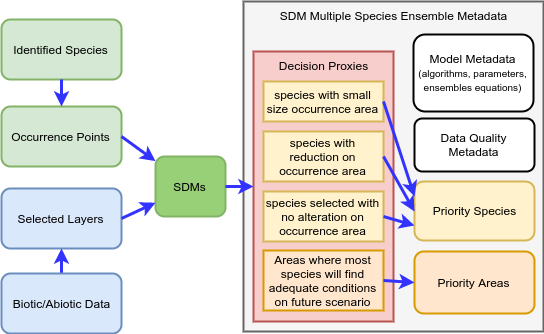|
Biodiversity Information Science and Standards : Conference Abstract
|
|
Corresponding author: Wilian França Costa (wilianfc@gmail.com)
Received: 03 Apr 2018 | Published: 21 May 2018
© 2018 Wilian Costa, Leonardo Miranda, Rafael Borges, Antonio Saraiva, Vera Imperatriz-Fonseca, Tereza Giannini
This is an open access article distributed under the terms of the Creative Commons Attribution License (CC BY 4.0), which permits unrestricted use, distribution, and reproduction in any medium, provided the original author and source are credited.
Citation: Costa WF, Miranda L, Borges R, Saraiva A, Imperatriz-Fonseca V, Giannini T (2018) The Need of Species Distribution Models Metadata: Using Species Distribution Model to Address Decision Making on Climate Change. Biodiversity Information Science and Standards 2: e25478. https://doi.org/10.3897/biss.2.25478
|
|
Abstract
Anthropogenic-induced climate change has already altered the conditions to which species have adapted locally, and consequently, shifts of occurrence areas have been previously reported (
Thus, with SDMs, four types of decision making information data regarding priority species and areas could be obtained (Fig.
Priority species and areas, SDM metadata, and proposed decision information proxies on climate change scenarios.
- Size of potential occurrence areas: species that have a small area of occurrence are potentially vulnerable, since they present endemism, usually living in restricted environmental conditions. In this case, any small change in environmental conditions can result in the extinction of the impacted species. Thus, this region needs to be protected.
- Difference between current and future area: species presenting the most significant reduction in potential areas should be prioritized by decision-makers. This measurement could be used as an indication of vulnerability.
- Even species that have no predicted area reduction or an increase could be prioritized in management programs due to its role in the complex interaction networks of ecosystem services, such as pollinators, seed dispersers or disease control. These species could be more resilient to network interaction changes due climate, and possibly are better able to provide their services in the extreme unfavorable climate scenarios.
- Areas that maintain higher species diversity in future scenarios: their protection could be prioritized in restoration and conservation programs. Especially in cases involving multiple species, those areas could be considered as climate refuges by decision-makers. Additionally, for the reconstruction and use of SDM published in peer-reviewed journals, it is necessary that all pieces of information about models, its generation, ensemble methods, data cleaning and data quality criteria applied should be available.
The availability of the four above mentioned types of information can help on decision-making strategies aiming the protection of priority species and areas. In conclusion, SDMs present essential information about the present and future impacts of projected climate change and their derived data could be preserved using a standard controlled vocabulary.
Keywords
Biodiversity, Metadata, Decision Proxy, Climate Change, SDM, Species Distribution Model, Darwin Core
Presenting author
Wilian França Costa
Funding program
We are grateful to National Council for Scientific and Technological Development (CNPq) for financial support (proc. 446167/2015-0, 381626/2016-4 and 380277/2018-2).
References
-
Rapid Range Shifts of Species Associated with High Levels of Climate Warming.Science333(6045):1024‑1026. https://doi.org/10.1126/science.1206432
-
Mapping Species Distributions: Spatial Inference and Prediction.1º ed.Cambridge University Press, Cambridge,New York,340pp. [ISBN978-0-521-70002-3]
